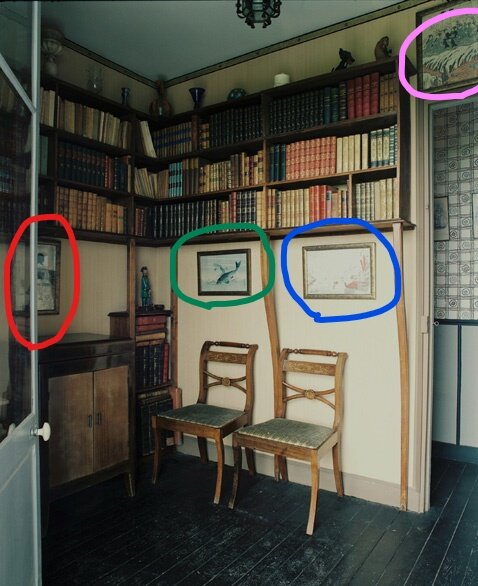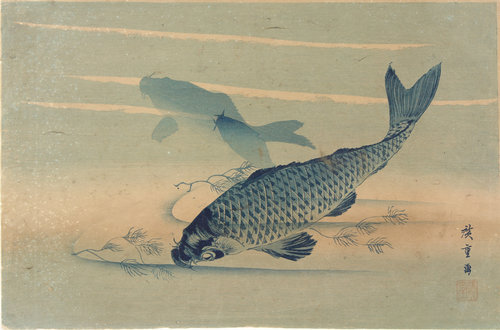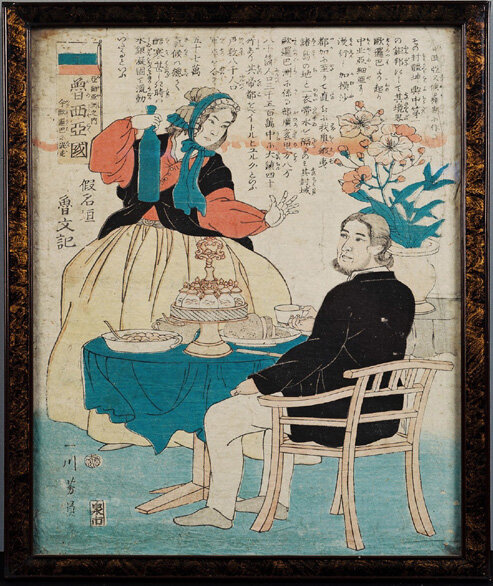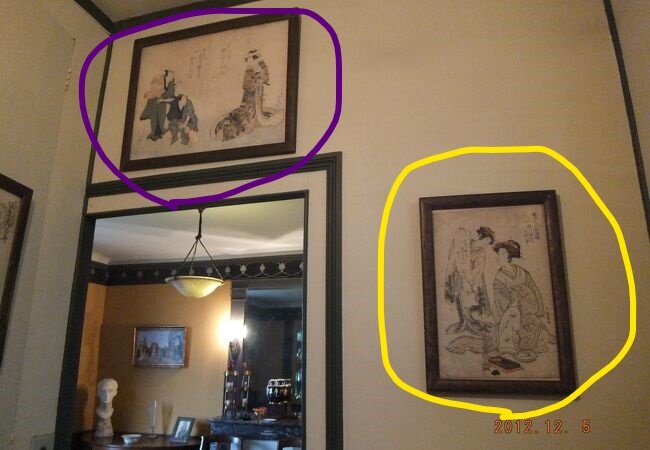M.Ravel and Japan #6 Ukiyoe (with new information) - Maurice Ravel's collection
Previously, in the post #2 Ukiyoe - Maurice Ravel’s Collection, we looked at some of the Japanese paintings Ravel owned at his house in Montfort l’Amaury. After the blog was posted in August in 2019 my master thesis made more progress and I discovered even more Japanese paintings at his house. I would like to talk about the newly identified Japanese paintings in this post.
This post has 5 parts:
Japanese paintings in La bibliothèque
Japanese paintings in La petit salon oriental
Other identified Japanese paintings at Ravel’s house
Unidentified Japanese paintings at Ravel’s house
Finally, but not the least importantly, my thought on using visual art to interpret invisible art.
La bibliothèque
https://www.guyvivien.com/guy-vivien-photos-ravel.html
The same paintings were discussed in the previous post Ravel and Japan #2.
This is the library room of Ravel in Montfort l'Amaury.
Red circle: Mother and Child (1793), by Kitagawa Utamaro
Green circle: Thre Carp, by Utagawa Hiroshige (style of)
Blue circle: Unidentified
Pink circle: Mitate of a daimyō procession along the bank of the Sumida River for cherry blossom viewing by Keisai Eisen
https://www.metmuseum.org/art/collection/search/54865
Red circle: Mother and Child (1793), by Kitagawa Utamaro
https://ukiyo-e.org/image/chazen/1984_1221
Green circle: Thre Carp, by Utagawa Hiroshige (style of)
https://www.guyvivien.com/guy-vivien-photos-ravel.html
Blue circle: Unidentified
Pink circle: Mitate of a daimyō procession along the bank of the Sumida River for cherry blossom viewing by Keisai Eisen
https://www.guyvivien.com/guy-vivien-photos-ravel.html
This is the other side of “La bibliothèque”.
Orange circle: the right half of Hiratsuka, 7th Station of the Tokaido by Utagawa Hiroshige
Brown circle: Biddende Hôjô no Tokimasa (1832) by Aoigaoka Keisei
https://www.artic.edu/artworks/32202/russia-oroshia-koku-from-the-countries-of-asia-ajia-shu-no-uchi
Orange circle: the right half of Hiratsuka, 7th Station of the Tokaido by Utagawa Hiroshige
https://www.guyvivien.com/guy-vivien-photos-ravel.html
Orange circle: the right half of Hiratsuka, 7th Station of the Tokaido by Utagawa Hiroshige
Ravel somehow only hang the right part of the Hiratsuka, 7th Station of the Tokaido on the wall.
https://www.guyvivien.com/guy-vivien-photos-ravel.html
Brown circle: Biddende Hôjô no Tokimasa (1832) by Aoigaoka Keisei. More information of this printing. (https://commons.wikimedia.org/wiki/File:Biddende_H%C3%B4j%C3%B4_no_Tokimasa-Rijksmuseum_RP-P-1958-576.jpeg)
2. La petit salon oriental
https://www.guyvivien.com/guy-vivien-photos-ravel.html
This is the room where Ravel placed his collection of Asian objects.
https://www.guyvivien.com/guy-vivien-photos-ravel.html
The other part of La petit salon oriental. Many objects are placed symmetry in Ravel’s house
https://www.guyvivien.com/guy-vivien-photos-ravel.html
The wall of La petit salon oriental
Light blue circle:Perspective View of French Churches in Holland, actually based on a print of the Roman Forum, c. 1770, Toyoharu Utagawa
Light green circle:Russia (Oroshia koku), from the Countries of Asia (Ajia shu no uchi), 1861, Utagawa Yoshikazu
https://ja.wikipedia.org/wiki/%E6%AD%8C%E5%B7%9D%E8%B1%8A%E6%98%A5#/media/%E3%83%95%E3%82%A1%E3%82%A4%E3%83%AB:Utagawa_Toyoharu_Rome.jpg
Light blue circle: Perspective View of French Churches in Holland, actually based on a print of the Roman Forum, ca. 1770, Toyoharu Utagawa
https://www.guyvivien.com/guy-vivien-photos-ravel.html
Light green circle: Russia (Oroshia koku), from the Countries of Asia (Ajia shu no uchi), 1861, Utagawa Yoshikazu
3.Other Identified paintings
A little bit more paintings that are partly identified.
This is the entrance of the house of Ravel.
Purple circle: not identified. Zoomed picture will be shown in 4.Unidentified paintings
Yellow circle:this is the picture below.
https://www.guyvivien.com/guy-vivien-photos-ravel.html
Isoda Koryusai(1735-1790)
https://www.guyvivien.com/guy-vivien-photos-ravel.html
Actor NakamuraTözö as Iwase Kibunta and Actor Nakamura Utaemon III as Jiraiya (1832) by Ryüsai (Ryütei) Shigeharu
https://www.guyvivien.com/guy-vivien-photos-ravel.html
Utagawa Kunihiro
4.Unidentified paintings
https://www.guyvivien.com/guy-vivien-photos-ravel.html
I found this painting upon the door of the composition room of Ravel’s house.
https://www.guyvivien.com/guy-vivien-photos-ravel.html
https://www.guyvivien.com/guy-vivien-photos-ravel.html
This is in La petit salon oriental
https://www.guyvivien.com/guy-vivien-photos-ravel.html
https://www.guyvivien.com/guy-vivien-photos-ravel.html
The purple circled painting from the entrance of the house.
https://www.guyvivien.com/guy-vivien-photos-ravel.html
5. My thoughts
We found that Ravel owned 17 Japanese printings in his house Montfort l'Amaury. But would identifying Ravel’s ukiyoe and Japanese painting collection actually help at all in the interpretation of his works? Of course we are here to investigate how much he was potentially influenced by Japanese arts in his real life and how much it could possibly appear in his music. But would the 17 paintings, or his interest in Japanese art necessary prove that his music was influenced by Japanese art?
I started this research because I knew Ravel owned a Japanese garden and Japanese prints. It turned out that his collection of Japanese printings was beyond my imagination but based on its existence alone, I still hesitate to say that this collection influenced his composition.
When I was writing my master thesis, one of the research advisors told me that:
“For example, if you try to interpret Baudelaire’s works by the influence of Haiku or something, you can do it by logical reasoning. You are trying to do your thesis with the scientific approach, and putting special emphasis on evidence. If you apply your methodology, however, half of the papers published by the humanities might have no meaning.”
I find it is nonsense to use sophistry to “interpret” a composer's work, or a poet’s work for that matter, and explain it with other, randomly chosen art. With this approach anything can be “interpreted” as something which has nothing to do with the original work. “Interpreting” a work of a composer should be done with respect and responsibility, not with an eccentric idea which is designed to catch the attention of people but has no actual meaning.
To write my thesis, I tried to search for an existing paper that talks about the same topic, Ravel and Japan. I found only a single paper Maurice Ravel’s “Color Counterpoint” through the Perspective of Japonisme (Stankis), in which the author provides “a historical and graphical context to demonstrate how Ravel’s musical textures may have been shaped by East Asian pictorial imagery.”
I am honestly disappointed how simplistic her approach in the paper is. For example, she talks about Hokusai because he was the most popular ukiyoe painter in Paris in the time of Japonisme. However, as we confirmed in this post, Ravel had no single painting by Hokusai, not even the fanous wave (in his last 16 years in Montfort l'Amaury), at least as far as I could identify. And remarkably, it seems like he was more interested in paintings of actores and actress, or humans, not so much nature.
She quoted from Fargue’s biographical sketch of Ravel saying
“As Hokusai was mad about drawing, Ravel was mad about perfection”.
It is possible to make an analogy between the two great artists, but which master is not mad about perfection? She also quoted other people’s thoughts about the resemblance between Hokusai and Ravel, however, that is as unreliable as finding Haiku influence in Baudelaire’s work based on some so-called logical reasoning. Moreover, can we become so sure that Ravel knew all of Hokusai’s paintings that she talks about in the paper?
In the paper, she chooses a Hokusai painting and draws lines and circles around its features to compare them with the composition of Ravel. To me it seems like the painting is chosen without any historical reason. Nevermind the fact of drawing analogies between high level layouts of a painting and classical music composition. To add to the argument, Stankis quotes Laloy’s review of the song by Ravel,
“These five little tableaux have a finesse and intensity of character unequalled, with the exception of certain Japanese landscapes whee one sees, as here, speckled birds stretching their wings above the setting sun which is obscured by pensive reed” (Laloy 1907, 156-57).
Stankis, Jessica E. 2015. “Maurice Ravel’s “Color Counterpoint” through the Perspective of Japonisme.” Society for Music Theory. https://mtosmt.org/issues/mto.15.21.1/mto.15.21.1.stankis.html
From this quotation, she postulates that Chidori Birds and Reeds by Sugakudo, which was well known among Parisian collectors, may possibly fit the description and thus be relevant to Ravel’s actual composition. Again, she draws lines and circles which imitate the structure of the painting, and goes on with her analogy between the painting and Ravel’s song.
To draw lines and circles in a randomly chosen ukiyoe and explain the resemblance of the resulting scribbles and one of Ravel’s works, means anything can be anything. Just like most of the art world today, everything is considered as art but nothing truly is art. But ultimately, this will fall apart as the late Roger Scruton so beautifully put it:
“Like adverts, today's works of art aim to create a brand, even if they have no product to sell except themselves.”
So I did not listen to my research advisor, or Stankis for that matter, and stayed on the loosely “scientific”, or maybe more accurately called “rational” path. In answering my research question “Was Ravel’s music influenced by Japanese art?” I applied the idea of the legal concept “preponderance of evidence”, meaning more likely than not to have occurred. My thesis thus took very careful steps, first I collected all the historical evidence that shows the connection between Ravel and Japan, as far as I could do for the two years of the master program in Conservatorium van Amsterdam. Then, I sorted them into two types: direct evidence and circumstantial evidence. Correspondences, testimony and diary entries are counted as direct evidence, other evidence such as his friend circle and interests are counted as circumstantial evidence. After gathering all the evidence, I judged them carefully and decided whether it is more likely than not that Ravel’s music was influenced by Japanese art.
I believe that only after taking these careful steps and considering the historical evidence one can make an actual “interpretation” of Ravel’s music in relation to Japanese art. All else would be irresponsible and disrespectful sophistry.
In the next post, I will talk about Ravel’s musician friends such as Delage, Stravinsky and Ingelbrecht, and their connection with Japan. Stories of Ravel’s experience in Japanese music will follow soon too. I am also thinking about starting a new series (or post) on music, but not only about Ravel. If you would like to be informed about new posts, please subscribe to my newsletter using the form below.
































